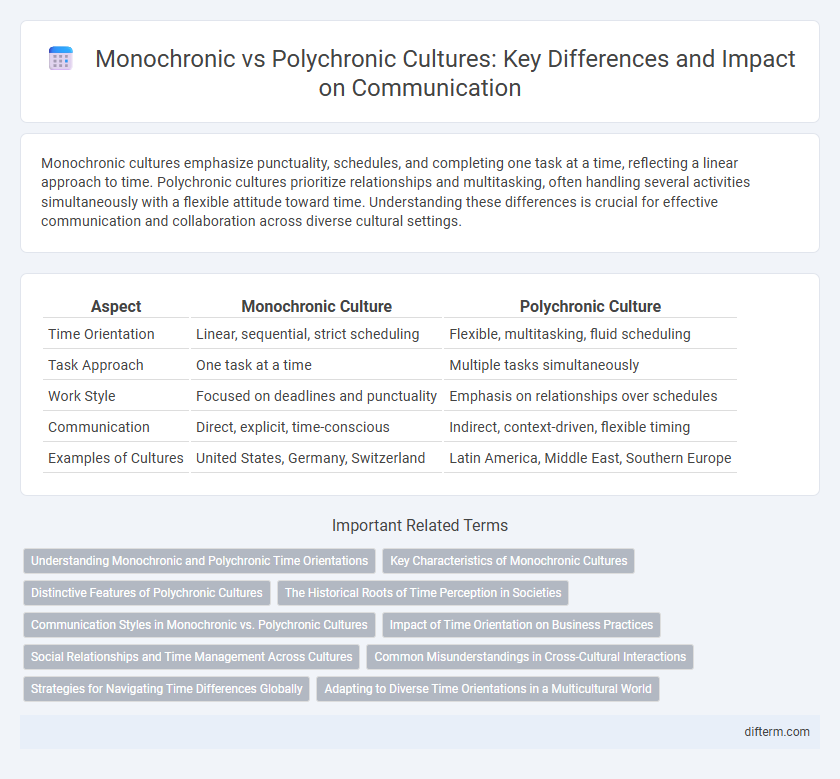Monochronic cultures emphasize punctuality, schedules, and completing one task at a time, reflecting a linear approach to time. Polychronic cultures prioritize relationships and multitasking, often handling several activities simultaneously with a flexible attitude toward time. Understanding these differences is crucial for effective communication and collaboration across diverse cultural settings.
Table of Comparison
| Aspect | Monochronic Culture | Polychronic Culture |
|---|---|---|
| Time Orientation | Linear, sequential, strict scheduling | Flexible, multitasking, fluid scheduling |
| Task Approach | One task at a time | Multiple tasks simultaneously |
| Work Style | Focused on deadlines and punctuality | Emphasis on relationships over schedules |
| Communication | Direct, explicit, time-conscious | Indirect, context-driven, flexible timing |
| Examples of Cultures | United States, Germany, Switzerland | Latin America, Middle East, Southern Europe |
Understanding Monochronic and Polychronic Time Orientations
Monochronic cultures prioritize punctuality, scheduling, and completing one task at a time, reflecting a linear approach to time management. Polychronic cultures emphasize multitasking, flexible time use, and maintaining relationships over strict adherence to schedules. Recognizing these time orientations improves cross-cultural communication and enhances collaboration in global environments.
Key Characteristics of Monochronic Cultures
Monochronic cultures emphasize punctuality, strict adherence to schedules, and completing one task at a time, reflecting a linear approach to time management. These cultures prioritize efficiency, deadlines, and organized planning, often valuing individualism and personal responsibility in work and social interactions. Countries such as the United States, Germany, and Switzerland exemplify monochronic cultural traits through their structured lifestyles and time-conscious behaviors.
Distinctive Features of Polychronic Cultures
Polychronic cultures emphasize multitasking and view time as flexible, prioritizing relationships over strict schedules. Social interactions and personal connections often take precedence, leading to fluid deadlines and overlapping activities. This cultural approach fosters adaptability and values human engagement above rigid time management.
The Historical Roots of Time Perception in Societies
Monochronic cultures, rooted in Western industrialization and Protestant work ethics, emphasize linear time, punctuality, and task completion as reflections of productivity and discipline. Polychronic cultures, often found in Indigenous, Mediterranean, and Latin American societies, derive their flexible time perception from communal activities, oral traditions, and cyclical natural rhythms that prioritize relationships over schedules. These historical foundations shape how societies value time management, influencing social interactions and organizational behavior across cultures.
Communication Styles in Monochronic vs. Polychronic Cultures
Monochronic cultures emphasize direct, scheduled communication, valuing punctuality and clear, linear conversations that prioritize task completion. Polychronic cultures prefer flexible, relationship-oriented communication, often engaging in simultaneous interactions and valuing context and emotional nuance over strict adherence to time. Understanding these distinct communication styles helps improve cross-cultural interactions and workplace collaboration.
Impact of Time Orientation on Business Practices
Monochronic cultures emphasize punctuality, schedules, and completing one task at a time, leading to structured business meetings and strict adherence to deadlines. Polychronic cultures value relationships and multitasking, often allowing flexibility in time and overlapping activities during negotiations and collaborations. Understanding these time orientations improves cross-cultural communication and project management, reducing conflicts and enhancing productivity in global business environments.
Social Relationships and Time Management Across Cultures
Monochronic cultures prioritize strict schedules and punctuality, emphasizing task completion and clear deadlines in social interactions. Polychronic cultures value flexible time management, fostering strong social relationships by multitasking and prioritizing human connections over rigid schedules. Understanding these differences enhances cross-cultural communication and collaboration by respecting diverse approaches to time and social dynamics.
Common Misunderstandings in Cross-Cultural Interactions
Monochronic cultures emphasize strict adherence to schedules and value punctuality, often leading to misunderstandings when interacting with polychronic cultures that prioritize relationships over precise timing. Cross-cultural confusion frequently arises from differing perceptions of time management, where polychronic individuals might be perceived as disorganized or disrespectful by monochronic counterparts. Recognizing that these time orientation preferences reflect deeper cultural values can reduce misinterpretations and foster more effective communication in international settings.
Strategies for Navigating Time Differences Globally
Recognizing that monochronic cultures prioritize strict schedules while polychronic cultures emphasize relationships and multitasking is crucial for effective global time management. Implementing flexible meeting times and using clear communication tools accommodates diverse time perceptions across cultures. Leveraging technology such as shared calendars and time-zone converters helps synchronize tasks and respect varying temporal approaches in international collaborations.
Adapting to Diverse Time Orientations in a Multicultural World
Monochronic cultures prioritize linear, scheduled time management, valuing punctuality and task completion, while polychronic cultures embrace flexible time with multitasking and relational priorities. Adapting to these diverse time orientations requires cultural sensitivity and effective communication strategies to bridge differences in time perception and workflow. Understanding monochronic and polychronic time concepts enhances global collaboration, reduces conflicts, and fosters inclusive multicultural environments.
Monochronic vs polychronic cultures Infographic

 difterm.com
difterm.com